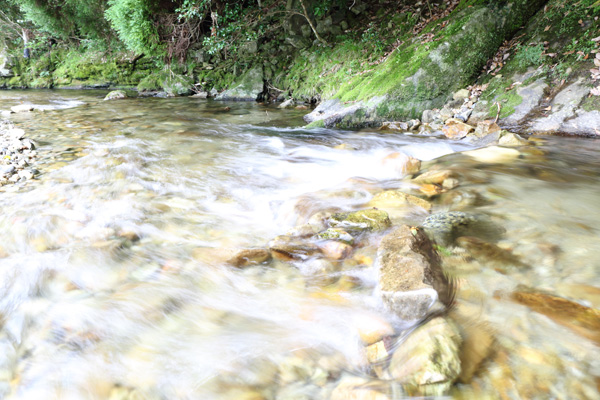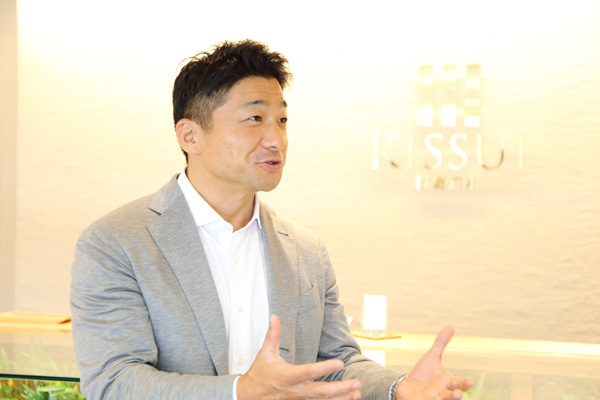New Era of Somen Turns Breakthrough into New Tradition

We visited Banshu, one of the most renowned districts of somen production in Japan, to explore the roots of long somen production and how it evolved.
A favorable climate gives birth to Banshu somen

Banshu refers to the area stretching from Himeji in the southwest area of Hyogo Prefecture, to the entire area of Ako. Banshu has the Setonai Sea to the south, the Tajima mountain range to the north and Mt. Rokko and Tanba to the east. It is an area blessed with rich natural beauty, with many pure streams like Kagogawa River and Ibo River flowing into the plain. This geography and the mild Setouchi climate bring quality wheat, salt and water, making Banshu fit for somen production from ancient times.

The salt from Ako is purportedly especially vital for Banshu somen. We visited salt manufacturer Nihon Kaisui Co. Ltd. in Ako, who has been producing salt since the Edo period (1603–1868).
Right now, Nihon Kaisui uses a cutting-edge technology – the ion exchange membrane method – to extract highly pure salt from large volumes of sea water drawn from the Seto Inland Sea. However, until about 1971, saltpans in Ako were using a traditional sun-dried method called the irihama style to make salt.

For the first time in Japan, reliable salt production became possible because of the great tidal range of the Seto Inland Sea, a climate without much rain or storms and the wisdom of predecessors who took advantage of these characteristics. Explaining the background of somen production in Banshu, Masayuki Sakagoe, head of the production group of Nihon Kaisui’s Ako Plant said, “Naturally, the salt was connected to wheat and pure water to spawn the somen culture in Banshu.”
The challenge of forging a new somen culture

Tatsuno, famous for its somen production, is located in between Himeji and Ako. Somen production started as a side business for the agriculture sector in the Edo period, by Ibo River running through the city. In ancient times, the city’s typical winter landscape included sun-dried somen.
Recently, a new hand-made somen brand came out of Tatsuno. The brand is Harima Kissui.
Harima Kissui is 1.0-1.5 mm thick, a bit thicker than regular Banshu somen. The company who created it did extensive research to explore the rich aroma of wheat. The new somen has been designed to fit Italian and creative cuisine and this novel idea is drawing attention.

Seiichiro Nakajima, representative of Harima Kissui, is the creator of the brand. Nakajima was once concerned about the somen market because, although annual somen production was high, it had plateaued as a low-price commodity. The market was also shrinking.
“Compared to udon and ramen, somen looks less glamorous. It has a long tradition but we were worried about how the market could grow in the future. I wanted to promote a new somen culture that matches the diversified food culture to give something back to my homeland of Banshu.”
After much trial and error with experienced craftsmen, Nakajima ended up with hand-made somen, smooth yet chewy, releasing wheat aroma fully as soon as it entered the mouth.
“People who love noodles love the wheat aroma. We successfully created bold noodles with a strong presence that is not just smooth,” says Nakajima confidently.
Hand-made somen created with expert intuition

We visited the Harima Kissui’s somen plant.
The plant starts operating at 4 a.m. The process starts by mixing wheat and brine. When the time needed to knead, mature and dry the dough is taken into account, they have no choice but to start early.
Harima Kissui’s somen is made from a unique blend of wheat, selected from a few dozen varieties. It is not the machine but the craftsmen’s job to see how much water and salt are needed for the wheat to knead it into dough.

“When I leave home and head to the plant in the morning I sense the day’s temperature and humidity. By the time I arrive at the plant I have a clear idea of how much water and salt to use. Then I touch the dough and if there is not enough water I wipe the barrel with a wet cloth to fine-tune the humidity,” says Chiaki Kojima, head of the plant.
The dough is matured and twisted, with processes called umashi and yori respectively. Repeating these processes creates Harima Kissui’s chewy texture, characteristic of hand-made noodles. These processes are not complete without expert intuition.

If maturing (umashi) is insufficient, the noodles break off when they are being elongated. By twisting noodles after maturing them thoroughly, the gluten inside mixes together and creates a strong body. Only skilled craftsmen with years of experience can see when the dough is mature enough and how much twisting is needed.
“The fun thing about making somen is it gets tastier the more care you put into it. We never reach perfection. Every day is a learning experience,” says Kojima.
Tradition with passion creates evolution

An increasing number of Japanese and other restaurants are introducing Harima Kissui somen into their menus, allured by the hand-made noodle.
Omotenashi Kiko, Japanese restaurant in Himeji, is one such restaurant. They serve creative dishes, assorting Harima Kissi somen with seasonal local ingredients.
One of them is a warm somen served with Kobe beef, Welsh onions and gold leaves. Harima Kissui’s somen’s perfect characteristic elasticity and fine wheat aroma are an elegant match with tasty beef and onion’s crispiness. We couldn’t help smiling because it tasted totally new and amazing.

“Unlike the regular somen, this has a far superior aroma. It also stays elastic over time and does not get slack. We can arrange it in winter menus too. It is great that we can combine it with a wide variety of ingredients. It changed the image I had of somen,” says head chef Tadamasa Yasuda.
Eager to promote somen’s wonders to many generations, Harima Kissui is rolling out many activities, not just to Japanese restaurants. The company has collaborated with a popular chef of Spanish cuisine to develop somen recipes, and is also collaborating with non-food businesses, including potters.

Having preserved 600 years of tradition, Harima Kissui is trying to move the tradition forward, adding new passion to tradition. It made us realize the inexhaustible potential of the number-one somen district of Japan.








